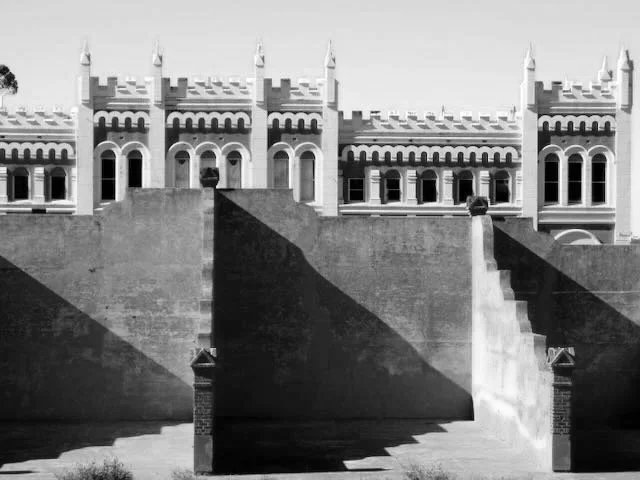Living Dangerously.
Schools allow children to choose to act as non-player characters for six hours a day.
They watch other students make decisions then act on them, and see the consequences for the child.
As the children grow older and spend time with their friends in other households, they witness how their friends operate within their families and how those families operate.
Living dangerously vicariously, and learning, without the consequences.
The Jailer is Watching.
It has been written that Leadership is confronting people with their freedom.
A word of warning to the novice Leader:
While you are beckoning people to emerge from their prison,
The Jailer is watching.
And is not happy.
Pebbles Voting.
The avalanche has already started. It is too late for the pebbles to vote. Michael Straczynski
This is the 'opposite end’ of the Bishop Desmond Tutu quote:
There comes a point where we need to stop just pulling people out of the river. We need to go upstream and find out why they’re falling in.
Mr Squiggle.
Anyone who grew up in Australia in the 1970s remembers the TV show - Mr Squiggle.
Very young children would send in ‘drawings’ of random lines, strokes, dots and curves.
A puppet called Mr Squiggle, aided by his friend Miss Jane and Rocket who acted as an easel, would use his pencil nose to join all the random markings and reveal a picture.
Usually Miss Jane would have to rotate the paper so we could see what only Mr Squiggle had discerned.
That’s the same way we create a narrative to explain what happened.
Almost always with us as the Hero.
Presenters.
Most presenters: I’m going to tell you what I know so you feel you don’t know and I feel good.
A great presenter: I’m going to tell you what I know so you know what you know and you feel good.
Crowd Surfing.
When I present, I toss ideas and concepts into the audience.
Many drop to the floor.
It only takes one to be caught, held aloft and crowd surf across the minds of the participants for Things to Change.
Here is Leadership, Management, and Teamwork in a nutshell:
Share something good with another and watch it come back better.
With someone else’s name on it.
We Need Our Johns.
John (not his real name) was a decent, good, honest man who held a senior role in a large organisation.
He was sincere, cared about his people, was approachable, technically competent, fair, down to earth and honest.
And he chose not to use his position to its fullest to call out and change the poor management of those around him.
Eventually John was head-hunted by another, larger organisation to lead it.
Some might judge John as lacking courage or integrity.
That’s idealistic romanticism.
Here’s the reality.
Mary, Jack, Jill, and Tom (not their real names) in John’s former organisation responded to the poor leadership by voting with their feet and leaving, or spoke up and were asked to leave, or had their promotion or oppportunities thwarted because they challenged the under performers, or just chose to stay low, shut up, and take their pay cheques.
Their decisions, while authentic and brave and true, meant the organisation and those it served lost the benefit of their gifts.
While John continued to serve his old organisation and now his new one with the valuable benefit of his talents and organisational wisdom and positive contribution.
All organisations need their Marys, Jacks, Jills and Toms.
They and we also need their Johns.
Time.
My father was deaf in one ear.
For as long as I can remember he would frequently say ‘What?…’ and lean forward and cup his ear.
It drove us mad.
We pleaded with him to get a hearing aid or have a specialist check if there was something to be done.
He reckoned the damage was caused by a virus in his youth, and there was nothing to be done.
So ‘What?…’. ‘What?…’ ‘What?…’ was the refrain in our household and at restaurants and footy games - day in and day out.
Today is the first time I’ve thought of this aspect of my beautiful Dad in over a decade since he died.
Integrity.
It’s easy to gain a reputation for integrity.
Never allow yourself to be in the position to test it.
Earning it demands the exact opposite.
Each Morning.
Each morning at the beginning of the school day, students walk through their school gate carrying all of society’s brokenness, failures, short-cuts, compromises, quick-fixes, short-term gratifications, wilful blindnesses, intergenerational trauma, neglect, secrets, unspoken grief, digital addictions, family conflict, loneliness, and quiet shame …
And Principals, teachers, staff, and fellow students receive it all, as a daily vocation to turn that hurt into healing, that confusion into learning, that loneliness and isolation into community, and that despair into hope.
Books.
At each stage of my life when I”ve stood at a crossroads - a book has appeared to move me forward.
Keith Miller’s biography ‘Cricket Crossfire’ as a boy taught me sportsmanship and camaraderie among men.
‘Reach for the Sky’ in my early teens taught me triumph over adversary and chivalry in war.
‘Emerson’s Essays’ in my mid-teens taught me about the divinity of loving someone who doesn’t love me back.
‘The History of Philosophy’ in my late teens taught me the riches of thought and that we stand on the shoulders of giants.
‘Jonathon Livingston Seagull’ in my late teens taught me that I was connected in my alone thoughts with others.
‘The Road Less Travelled’ in my early twenties taught me from its opening sentence: ‘Life is difficult’.
And the Bible has taught me different things at each stage of my life I've opened it.



















